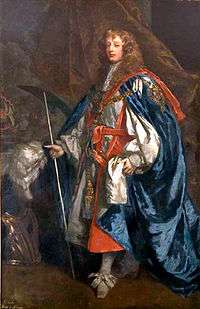Charles Stewart, 3rd Duke of Richmond

Charles Stewart, 3rd Duke of Richmond, 6th Duke of Lennox KG (7 March 1639 – December 1672) was the only son of George Stewart, 9th Seigneur d'Aubigny and Katherine Howard, daughter of Theophilus Howard, 2nd Earl of Suffolk. He was the grandson of Esmé Stewart, 3rd Duke of Lennox.
On 10 December 1645 he was created Baron Stuart of Newbury, Berkshire, and Earl of Lichfield, titles conferred on him "to perpetuate the titles which were intended to have been conferred on his uncle" Lord Bernard Stewart, youngest son of the Duke of Lennox, who had been killed in the Battle of Rowton Heath in the English Civil War in September of that year.[1]
In January 1658, Charles Stewart went into exile in France, and took up his residence in the house of his uncle, Ludovic, seigneur d'Aubigny. In the following year he fell under the displeasure of The Protectorate's Council of State, and warrants were issued for seizing his person and goods.[2]
Charles Stewart married, firstly, Elizabeth Rogers, after June 1659. He married, secondly, Margaret Banaster, on 31 March 1662. He married, thirdly, Frances Teresa Stewart, granddaughter of Walter Stewart, 1st Lord Blantyre, in March 1667. This last marriage was famous, as Frances Stewart had been desired by Richmond's cousin, King Charles II, as a mistress.
Charles Stewart returned to England with Charles II in 1660, and sat in the Convention Parliament, showing great animosity towards the supporters of the Commonwealth.[2] On the death of his 10-year-old cousin Esmé Stewart on 10 August 1660, Charles Stewart succeeded as third Duke of Richmond and sixth Duke of Lennox.[1] In that same year he was created Hereditary Great Chamberlain of Scotland, Hereditary Great Admiral of Scotland, and Lord-Lieutenant of Dorset. On 15 April 1661 he was invested with the Order of the Garter.[2]
On the death of his uncle, Ludovic Stuart, he succeeded him as 12th Seigneur D'Aubigny, for which title he did homage by proxy to Louis XIV of France on 11 May 1670. In July 1667, on the death of his cousin, Mary Butler, countess of Arran, he became Baron Clifton, and on 4 May 1668 he was made lord lieutenant and vice admiral of Kent jointly with the Earl of Winchilsea.[2]
In 1671 he was sent as ambassador to the Danish court to persuade Denmark to join England and France in a projected attack on the Dutch. While there he died (by drowning) in 1672, aged 33 at Elsinore,[1][2] without issue, and his titles became extinct, with the exception of Baron Clifton, which passed with most of his property to his sister Katherine, Lady O'Brien. He was buried on 20 September 1673 at Westminster Abbey.
The titles Duke of Richmond, Duke of Lennox and Earl of March, were resurrected for Charles II's illegitimate son by Louise de Kérouaille, Charles Lennox, 1st Duke of Richmond and Lennox, in 1675.
See also
| Honorary titles | ||
|---|---|---|
| Interregnum | Lord Lieutenant of Dorset 1660–1672 |
Succeeded by The Lord Ashley |
| Preceded by The Earl of Winchilsea The Earl of Southampton |
Lord Lieutenant of Kent 1668–1672 |
Succeeded by The Earl of Winchilsea |
| Vacant Title last held by Sir Thomas Walsingham |
Vice-Admiral of Kent 1668–1672 | |
| Peerage of Scotland | ||
| Preceded by Esmé Stewart |
Duke of Lennox 1660–1672 |
Extinct |
| Peerage of England | ||
| Preceded by Esmé Stewart |
Duke of Richmond 1660–1672 |
Extinct |
| Preceded by New creation |
Earl of Lichfield 1645–1672 |
Extinct |
| Preceded by Mary Butler |
Baron Clifton 1668–1672 |
Succeeded by Katherine O'Brien |
Notes
References
- Money, Walter (1881). The First and Second Battles of Newbury and the Siege of Donnington Castle During the Civil War, A.D. 1643-6. Simpkin, Marshall and co. Retrieved 2009-03-01.
 "Stuart, Charles (1640-1672)". Dictionary of National Biography. London: Smith, Elder & Co. 1885–1900.
"Stuart, Charles (1640-1672)". Dictionary of National Biography. London: Smith, Elder & Co. 1885–1900.